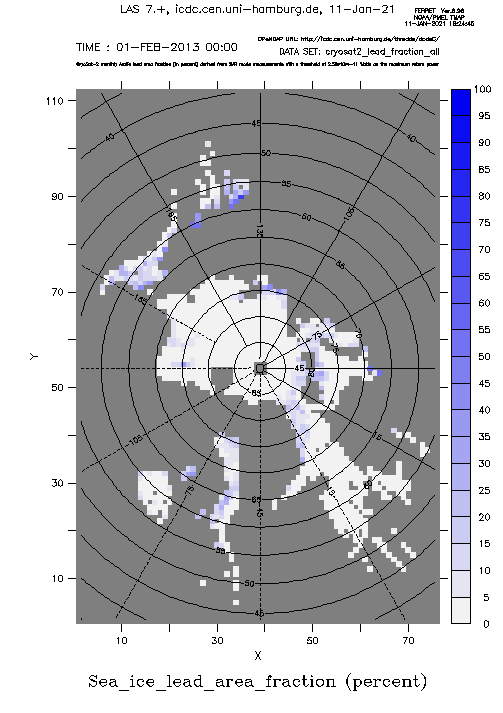Lead Area Fraction for Arctic from CryoSat-2

Topics
- Access
- Description
- Parameters
- Coverage, spatial and temporal resolution
- Data quality
- Contact person
- References
- Data citation
Access
UNRESTRICTED:
RESTRICTED:This link to the data set is only available for a restricted user group. The data set is only accessible in CEN/MPI net or accessible from external nets with a customer account. Please contact ICDC if you would like to access this data from outside the network.
- Data access via file system: /data/icdc/ice_and_snow/arctic_lead_fraction_cryosat2
Description
Data obtained with the SIRAL instrument aboard the CryoSat-2 satellite are used to produce a data set of the percentage lead area fraction for winter months January, February, and March on the NSIDC polar-stereographic grid with 100 km grid resolution.
The first step is a supervised classification of different parameters derived from SIRAL measurements. The results of the classification are inter-compared with contemporary MODIS visible imagery with the goal to find the best parameter / parameter combination to identify leads in Arctic sea ice. The parameter with the best classification agreement to the MODIS imagery which - among the pulse peakiness - is the maximum power of the waveforms is used to derive the Arctic lead area fraction offered here.
For more details of the methodology and potential limitations we refer to the publications given in the references.
This data set is a CliSAP/KlimaCampus product.
Last update of data set at ICDC: October 9 2015
Parameters
| Name | Range |
|---|---|
| Lead Area Fraction | 0...100% |
| Number of data per month and grid cell | - |
| Land mask | 0, 1 |
| Sea ice mask | 0, 1 |
Coverage, spatial and temporal resolution
Period and temporal resolution:
- 2011-2015
- Monthly, January to March (2015: February)
Coverage and spatial resolution:
- Northern hemisphere
- Spatial resolution: 100 km x 100 km, polar-stereographic grid from NSIDC, tangential plane at 70°N and 70°S, respectively
- Geographic longitude: -180°E to 180°E
- Geographic latitude: from about 41°N to 90°N, in the corners of the grid further equatorward
- Dimension: 76 columns x 112 rows
- Altitude: 0.0 m
Format:
- NetCDF
Data quality
The data set does not contain uncertainty estimates.
The validation of the lead detection mainly took place based on a comparisons between contemporary visual MODIS scenes and CS-2 tracks. The used classifier has been optimized by these scenes to minimize miss-classification of ice as leads and vice versa.
Independent validation by additional scenes confirms that nearly all leads wider than 250 m are detected. The detection behavior below this width cannot be quantified. Leads covered by newly formed thin ice are also detected but an upper boundary of ice thickness (or age) cannot also be estimated due to missing validation data.
The general lead distribution shows reasonable regional pattern and spatial transitions with slightly higher lead fractions than in previous estimates. This difference to those can be well explained by the ability to detect smaller leads compared, e.g., to the approach used to detect leads from AMSR-E data at ICDC. Please refer to the references for more details.
Contact
Andreas Wernecke
Institute of Oceanography / CEN / University of Hamburg
email: andreas.wernecke (at) uni-hamburg.deLars Kaleschke
Alfred Wegener Institute for Polar and Marine Research / Bremerhaven
email: lars.kaleschke (at) awi.deStefan Kern
ICDC / CEN / University of Hamburg
E-Mail: stefan.kern"AT"uni-hamburg.de
References
Literature:
- Wernecke, A., and L. Kaleschke, Lead detection in Arctic sea ice from CryoSat-2: quality assessment, lead area fraction and width distribution, The Cryosphere, 9, 1955-1968, 2015, doi: 10.5194/tc-9-1955-2015
- Wingham, D., et al., CryoSat: A mission to determine the fluctuations in Earth's land and marine ice fields, Advances in Space Research, 37, 841-871, 2006
Data citation
Please cite the data as follows:
"CryoSat-2 lead area fraction for the Arctic, [PERIOD], Integrated Climate Date Center (ICDC, icdc.cen.uni-hamburg.de/), University of Hamburg, Hamburg, Germany, [Month, Year]"
and the main publication Wernecke and Kaleschke (2015) when using this data.
and with the following acknowledgments:
Thanks to ICDC, CEN, University of Hamburg for data support.
